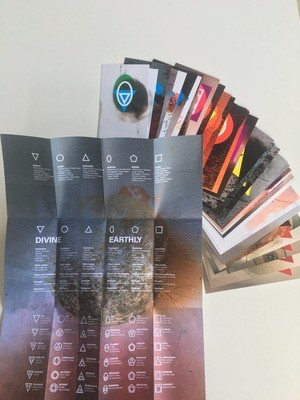Syzygos is numbered with Strong's Concordance 4805 it is used once in the Greek New Testament Philippians 4:3 (We will look at Philippians 4:3 below) it is not used in the Septuagint. However the word comes from another root word 4801 this word is used 4 times 2 in the Septuagint and 2 in the Greek New Testament
LXX Ezekiel 1:11 And the wings of the four were expanded upwards, each having a pair expanded adjoining each other and a pair<4801> folded on their body.
LXX Ezekiel 1:11 And the four had their wings spread out above; each one had two joined to one another<4801>, and two covered their bodies.
LXX Ezekiel 1:23 And their wings which were expanded below the firmament, flapped one against another, while every one had a pair <4801> that covered their bodies. {sunezeugmenai, joined with }
Mt 19:6 Wherefore they are no more twain, but one flesh. What therefore God hath joined together <4801>, let not man put asunder.
Inherited from Ancient Greek σύζυγος (súzugos, “mate, yoked together”), from συ(ν) (su(n), “together”) + ζυγός (zugós, “yoke, pair”), from Proto-Indo-European *yewg- (“to join, tie together”).σύζυγος • (sýzygos) m or f (plural σύζυγοι)
Strong's Concordance: 4805. σύζυγος, ου, ὁ
Part of Speech: Adjective
σύζυγος suzugos sood’-zoo-gos; from 4801; co-yoked, i.e. (figuratively) as noun, a colleague; probably rather as a proper name; Syzygus, a Christian: — yokefellow. ]
Thayer's Greek Lexicon:
STRONGS NT 4805: σύζυγοςσύζυγος (L T Tr WH συνζυγος (cf. σύν, II. at the end)), συζυγον, (συζεύγνυμι), yoked together; used by Greek writers (from Aeschylusdown) of those united by the bond of marriage, relationship, office, labor, study, business, or the like; hence, a yoke-fellow, consort, comrade, colleague, partner.
Accordingly, in Philippians 4:3 most interpreters hold that by the words γνήσιε σύζυγε Paul addresses some particular associate in labor for the gospel. But as the word is found in the midst of (three) proper names, other expositors more correctly take it also as a proper name ((WHmarginal reading Συνζυγε); see Laurent, Ueber Synzygos in the Zeitschr. f. d. Luther. Theol. u. Kirche for 1865, p. 1ff (reprinted in his Neutest. Studien, p. 134f)); and Paul, alluding (as in Philemon 1:11) to the meaning of the word as an appellative, speaks of him as 'a genuine Synzygus', i. e. a colleague in fact as well as in name. Cf. Meyer and Wiesinger at the passage; (Hackett in B. D. American edition under the word ).
As noted above the Greek word 4805. σύζυγος comes from another Greek word 4801 συζεύγνυμι
Part of Speech: Verb:
4801. συζεύγνυμι suzeugnumi sood-zyoog’-noo-mee; from 4862 and the base of 2201; to yoke together, i.e. (figuratively) conjoin (in marriage): — join together.
4801 syzeúgnymi (from 4862 /sýn, "identified with" and 2201 /zeúgos, "yoke") – properly, jointly-yoked; yoked (paired) together, when God joins two people together for one purpose (Mt 19:6; Mk 10:9).
4801 /syzeúgnymi ("closely-yoked") is only used for marriage in the NT – a union in which a husband and wife live better for the Lord together, than either would do alone.
Mr 10:9 What therefore God hath joined together <4801>, let not man put asunder.
From Matthew 19:6 And Mark 10:9 we can see that 4801 would symbolize a wife or a marriage union
Php 4:3 And I intreat thee also, true yokefellow <4805>, help those women which laboured with me in the gospel, with Clement also, and with other my fellowlabourers, whose names are in the book of life.
Possibly Paul has a particular brother in mind here: he seems to enlist the aid of a third party, Syzygus (sig "yokefellow", whom he challenges to live up to his name and be a "loyal yokefellow" ("gnesie syzyge") by bringing these women together. (Another Pauline play on a personal name occurs in Phm 1:10,11.) It is possible, of course, that there was no brother by the name Syzygus, and that this is an appeal to an otherwise unnamed brother -- but in that case, how would the Philippians know to whom this exhortation is addressed? The other alternative is that this is a general appeal to any and all in Philippi, to help with this reconciliation between Euodias and Syntyche.
The term "yokefellow" συζυγος — some have understood as a proper name, (Syzygus;) so the word can be used as a noun
The first pair in the bible is Adam and Eve than Cain and Abel (Sin and righteousness) Abraham and Sarah, David and Jonathon, Samson and Delilah, Solomon and the queen of Sheba, Jacob and Esau, Mary and Martha, Moses and Aaron. Sodom and Gommorah, Urim and Thummim
Besides their upper couple of wings and their lower couple of wings Each cherub had two joining to each other, and two were covering their bodies.”—Ezekiel 1:10, 11
For more information see my study on the cherubim
The Symbolism of The Cherubim
Just few of the Persons, things and places which are Twosomes in the scriptures
Acts 12:14 And when she knew Peter's voice, she opened not the gate for gladness, but ran in, and told how Peter stood before the gate.
15 And they said unto her, Thou art mad. But she constantly affirmed that it was even so. Then said they, It is his angel.
It is evident that the Apostles believed that they each had an Angel. When Peter was released from prison, he came to Mary’s house, and knocked on the gate. A young damsel “when she knew Peter’s voice, she opened not the gate for gladness, but ran in, and told how Peter stood before the gate.
And they said unto her, Thou art mad. But she constantly affirmed that it was even so. Then said they, it is his Angel” (Acts 12:14-15). Thus, not believing that Peter had been released, in seeking for an explanation, they said “it is his Angel”. Mat. 18:10; 2:13, 19; Psa. 34:7; Heb. 1:14 (Diag.).
our Personal Angels are our Divine reflection this can be seen also in the Gospel of Thomas Saying 108 Jesus said, "Whoever drinks from my mouth will become like me; I, too, will become that person, and to that person the obscure things will be shown forth."

Aeon: God's consciousness and substance goes through emanations that expand into pairs of male and female aspects of God's consciousness or mind as well as external entities from his substance or essence.
Depth and Silence (unknowable God),
Mind and Truth (comprehensible God),
Word and Life (active God),
Humanity and Church (immanent God).
2 The same was in the beginning with God.
3 All things were made by him; and without him was not any thing made that was made.
4 In him was life; and the life was the light of men (men refers to the Elect thus the Church).
5 ¶ And the light shineth in darkness; and the darkness comprehended it not..
Theos=Depth (male) and Silence (female) these make up the Monad of the transcendent Deity or the Uncreated Eternal Spirit next emanating from the Uncreated Eternal Spirit is Word (male) and Life (female) (Logos and Zoe) here Zoe being feminine would correspond to Sophia wisdom.
Life has a much more close relationship to the Logos than the “all things,” that "Life in him" is, in fact, his companion. Even the formation of the “all things,” mentioned in v3 above seems to be now assign to Life, the female aspect and/or syzygy of the Logos, as it is she who gives birth to, manifests and forms the next pair of emanations, Man and Church.
next Mankind and Church (Anthropos and Ekklesia) the life was the light of men Light has its partner Truth and because the light is the light of men this refers to Mankind but only the the Elect and there for Anthropos partner would be Ekklesia the Church
In other parts of the Bible the Church is called the fullness (pleroma) of Christ Ephesians 1:23 this is why in Valentinian text the like the Tripartite Tractate and the Valentinian Exposition the Church is one of the primal aeons or as in the Tripartite Tractate
The Valentinian Exposition The Nag Hammadi Library puts it this way:
That Tetrad projected the Tetrad which is the one consisting of Word and Life and Man and Church. Now the Uncreated One projected Word and Life. Word is for the glory of the Ineffable One while Life is for the glory of Silence, and Man is for his own glory, while Church is for the glory of Truth.
These are a aspects or attributes of the Pleroma the spiritual heavens the Uncreated One has his own attributes
This, then, is the Tetrad begotten according to the likeness of the Uncreated (Tetrad).
Syzygos is used in Gnostic text to demonstrate that God is androgynous being made up of male and female pairs attributes or aspects or union of a pair of aeons in the Pleroma
God is one but his attributes are many
The Father is singular while being many, for he is the first one and the one who is only himself. Yet he is not like a solitary individual. Otherwise, how could he be a father? For whenever there is a "father," the name "son" follows. But the single one, who alone is the Father, is like a root, with tree, branches and fruit. (The Tripartite Tractate)
In the Pleroma the each image of the One (an aeon) are androgynous which is to say, singular aspects that possess both male and female genders or names. For example the transcendent Deity has male and female aspects (or names) this makes the the transcendent Deity the androgynous Parent the Father and the Mother.













